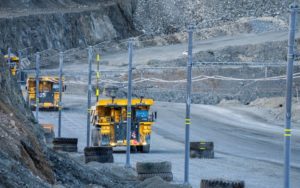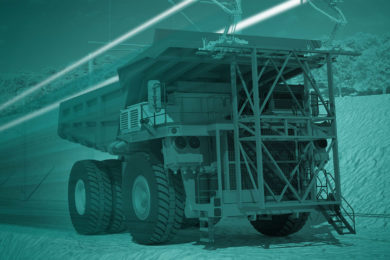In a November 2023 article entitled ‘Mining’s Green Revolution: Charting the Course Toward Decarbonisation,’ Wabtec said that it has been leading the way with decarbonising electrification solutions that allow mines to gain valuable insights into their operations and make data-driven decisions to help increase output and reduce costs.
And one of the first moves by miners is mining truck electrification. IM Editorial Director, Paul Moore, recently interviewed Joy Mazumdar, VP of Technology at Wabtec, about trolley assist’s potential to evolve to meet mining’s decarb challenges, including using different power sources, and what that means from a technology point of view on the truck.
Joy Mazumdar, VP of Technology at Wabtec

Mazumdar commented in the article: “Today, there are mines that still run mechanical equipment. We want to present them with the option to use electrified equipment, because electrification brings efficiency and that is one of the drivers toward achieving reduced emissions. Wabtec has been a leader in this space and our modern, AC electric drive systems have been in the market since the early 90s. So, we think it is definitely time to make that switch and for mines to go electric.”
Other areas of innovation from Wabtec include the use of liquid cooling for mining equipment, and trolley assist technology, which pulls power from an overhead line, allowing a vehicle to run at twice its normal speed and saving 90% fuel while on grade. The introduction of Wabtec’s high voltage propulsion system allows the mining truck to pull more power, leading to higher productivity – all while utilising the same truck deck space that’s available and lowering the carbon footprint.
Q Trolley has been around for a long time – what role does it have in reducing emissions today and where does the greatest demand lie?
Trolley technology fits the requirements today for decarbonising mining trucks very well as it has been around for a long time and so is well proven. But the reality today is that it is less about greenfield trolley operations and more about mines that already have electric drive mining truck fleets and that also have a profile that fits a trolley operation. How do you make those trucks capable running on trolley? So that is something we really started looking at. In a new mine of course you can do everything from the factory and that’s great. But what about existing mines? So that was the step we took at Wabtec – to look at what would be a solution or a group of solutions that makes trolley possible at an already operating mine. The actual trolley line is not the biggest challenge. The challenge is that the trucks are already in production and taking a large mining truck out of production for any length of time is not a desirable situation. So, we considered how could we pull a truck out of production, fit it with trolley equipment, and send it back to production? We opted to create a kit that could be provided to the mine for a conversion time of less than a week.
Q What about truck age – does that have a big impact on possibilities such as a newer Komatsu 930E-5 versus an older model?
It is all possible, but just the contents of the kit will differ. The newer truck likely already has upgraded power devices and electrical components needed to do the conversion. If it’s an older truck, then the components supplied in the kit will reflect the greater amount of work that needs to be done. So that’s what we have designed into our kits. The other thing that we did was decide that the pantograph structure should be the same regardless of the truck age and class for commonality. It should be the same because in the end the pantograph does is pulling the power and takes it to the wheel. We said depending on the truck payload, we know what kind of power will be needed and we designed the pantograph to allow for the highest power levels. This makes implementation much simpler and allows for mixed truck class fleets as well. And back to your point on older and newer trucks – we have already supplied kits for conversion of existing 830E trucks at Copper Mountain for example, followed by kits for new 830E-5 trucks that they then added.
Q What are the biggest headaches for converting an older truck to trolley?
Say the truck is around 15 plus years old, the semiconductors used then versus what we use today are different and will need replacing. Some of the controls have also changed so these would need upgrading as well. But the most important point is that when you have a truck running on diesel versus one running on trolley, you significantly increase the power. That’s how you get twice the speed. So, you have to add components that can handle it – mainly in the inverter cabinet. This means you upgrade the bus bars and the capacitors. We call this our inverter upgrade kit.
Komatsu 830E trucks under trolley at Copper Mountain

Q So overall, this is a full solution from Wabtec – what actual models of electric drive can you convert with these kits and where regionally is the demand coming from?
We can convert any trucks that have the Wabtec (formerly GE) AC drive system, as if you have a Wabtec inverter then you can modify the controls. So that includes Komatsu 730E, 830E, 930E and 980E trucks but also Chinese market leaders NHL and XCMG in China, as well as BELAZ and others. The ChargeOn Innovation Challenge was a big boost for existing fleet electrification work, and today we see a lot of activity, especially in Chile, Peru and Australia. In IM for example, you have already reported on the big mines looking at trolley such as Glencore Lomas Bayas, BHP Escondida and AMSA Los Pelambres. For mines that actually have mixed brands of trucks, however, they need to bear in mind that different truck OEMs have different truck voltages and then you have the trolley line itself that’s set up at a certain voltage. A higher voltage line might be chosen as you can draw in more power but the trucks that you are trying to convert might operate at a lower voltage. So things brings in an additional design element and you have to put in additional equipment which can cause project delays.
Q What is next for trolley beyond conventional trolley technology? When will we see battery trolley operations and what is Wabtec’s role in that arena?
Of course, that is true, the big surge in the technology in the next couple of years will be battery trucks as initial models start getting into the mines; and of course battery trolley will have an important role to play. Yes, we are well advanced in battery trolley programs – what we are actively working on right now is a drive system that is flexible enough to work with any power source. The OEM’s truck could come with any power source whether it be battery-diesel hybrid, all battery, fuel cell-battery or something else. We are able to take that power, convert it, and run our propulsion system with that power. And this includes taking trolley into account – your truck, if it has trolley, it doesn’t matter what the onboard power source is, the system will allow for that. The technology will be flexible enough that the power system doesn’t matter, you will only change the interface box. In the future this may mean that you have possibility to have a power interoperable truck.
Q So what do these power agnostic interface boxes actually require or involve?
They will have to handle the power source involved – a fuel cell for example will have a different voltage to a battery, then trolley is a higher voltage source. The box will convert the power to what we need to provide the necessary propulsion piece. The box will work with our latest liquid cooled high voltage inverter system which will be common to all the different power source scenarios.
Q Of the different power scenarios, is battery trolley the most likely to be first given that it eases some of the battery charging challenges?
Actually, we think the first move will be a lot more conventional diesel trucks being put under trolley. That is despite having to work through mine planning changes and ramp changes etc. Trolley brings them that instant reduction in fuel use and emissions they are looking for without any fundamental changes. Plus, you are hauling faster and so hauling more. Battery has its own issues – how do you charge it and when do you charge it – and these issues are still in the process of being evaluated. Once you have the trolley system in place for the diesel trucks with electric drive, you can relatively easily swap in the battery via retrofit a battery trolley system. And when the ex-factory battery trucks are available then can be phased in with the trolley system too. Using our inverter box technology, it should also be possible to phase in battery where you may have a mix of diesel-electric and battery trucks using the same trolley line.
Q Where does Wabtec stand on the use of biodiesel as well as emerging alternative fuels such as so-called e-fuels?
There are a lot of studies with mining customers and others going on in the market on alternative fuels, as well as other routes like hydrogen engines. And we are involved with some of these. But a lot of this is only early stage – when you talk about short term timelines of implementation, battery will be the next big phase, and I include battery trolley in that. Another development in the battery mining truck space is if you have a trolley, and in the future if you convert your trucks to battery, how do you achieve the highest efficiency of dynamic charging possible – so you design in enough dynamic charging so that you get the point where you may not need static charging at all.
Q Looking at dynamic charging of battery under trolley – what progress has Wabtec made there?
When I said before we have designed our pantograph for high voltage, another reason for doing this is that it a high voltage pantograph in many cases should accommodate dynamic charging as you are only using part of that power for the truck propulsion and the rest for charging – so as you are travelling up the ramp, you are propelling the truck and charging the battery simultaneously.
Q Could you supply a dynamic charging trolley system today if the battery truck was ready?
The trolley system itself is ready – the charging piece of course will be available when those first battery trucks are commercially available in 2027 onwards. And, in fact, we could do it today if the trucks were ready today. It has already been demonstrated by Komatsu at its Arizona Proving Grounds with its upgraded EVX (battery) truck to the GHG Alliance members as announced in May last year. But it is more complicated than just testing it on one truck – you need to be sure it can work with a fleet of trucks as well. What happens when at one point in time you have multiple trucks on the trolley line at the same time, then several disconnect and you have one truck left on the line? We need to be able to manage that energy balance and flow. That energy management part is where much of our work is today. You need to be able to cool the systems effectively as well. Finally, space is also a challenge on the truck – you cannot inhibit the operator’s view. We need to ensure we can increase the inverter power capacity without increasing the inverter box footprint and at the same time not creating any thermal issues. And the system may have to be able to switch power source to a temporary source like BESS if there is a grid issue for example. All of these power transitions have to be seamless for the operator – they should just have to drive the truck.
Q On the topic of the operator – on today’s trolley systems they need to operate a switch for the pantograph to engage and disengage – when will this become automated? And what about AHS trucks on trolley?
Yes, we are working on a system where the pantograph will engage and disengage automatically and will maintain the correct connection tension with the trolley line at all times even if there are ruts in the road. It has been tested at lab scale but not on a full scale truck yet. Another reason for doing this is ensuring the truck is on trolley as soon as possible – with an operator engaging the pantograph, the truck may already some metres under the trolley before engaging happens. Over hundreds of truck trips this can affect productivity. This won’t happen with an autonomous system. Other technologies that we have already rolled out include trolley adaptations for Arctic conditions where if the lines are iced up they have had to be manually scraped. Instead, we actually use the pantograph to draw current to melt the ice. Finally, to your question about AHS trolley trucks, that combination of autonomous haulage with zero emissions is something all the major stakeholders are working on, and I think you will see some major announcement on that in the next year or so.










